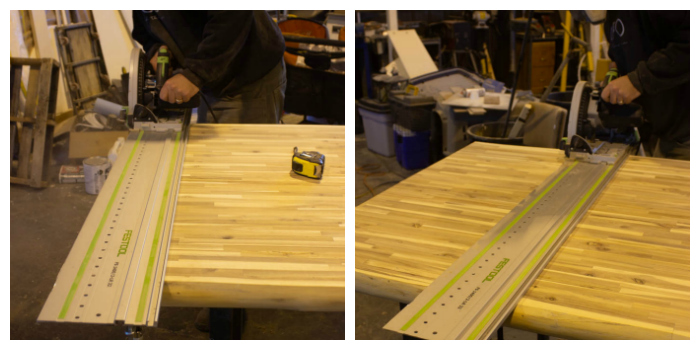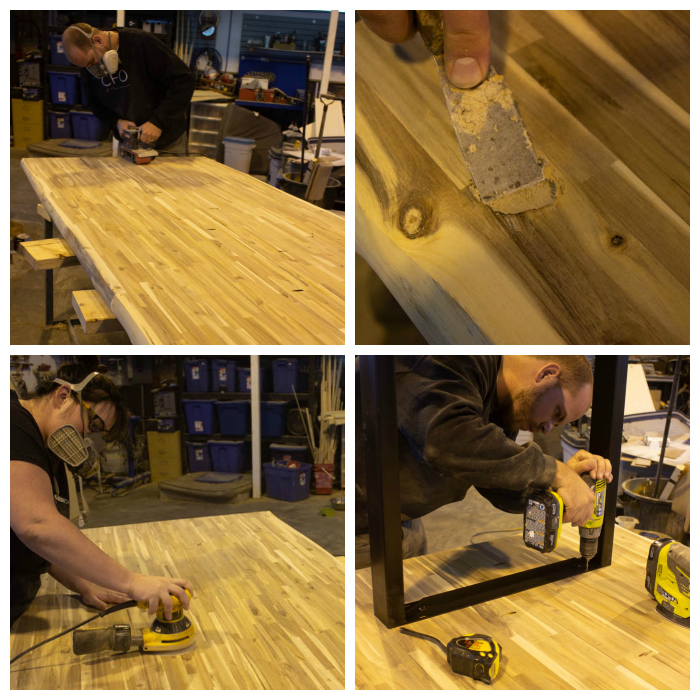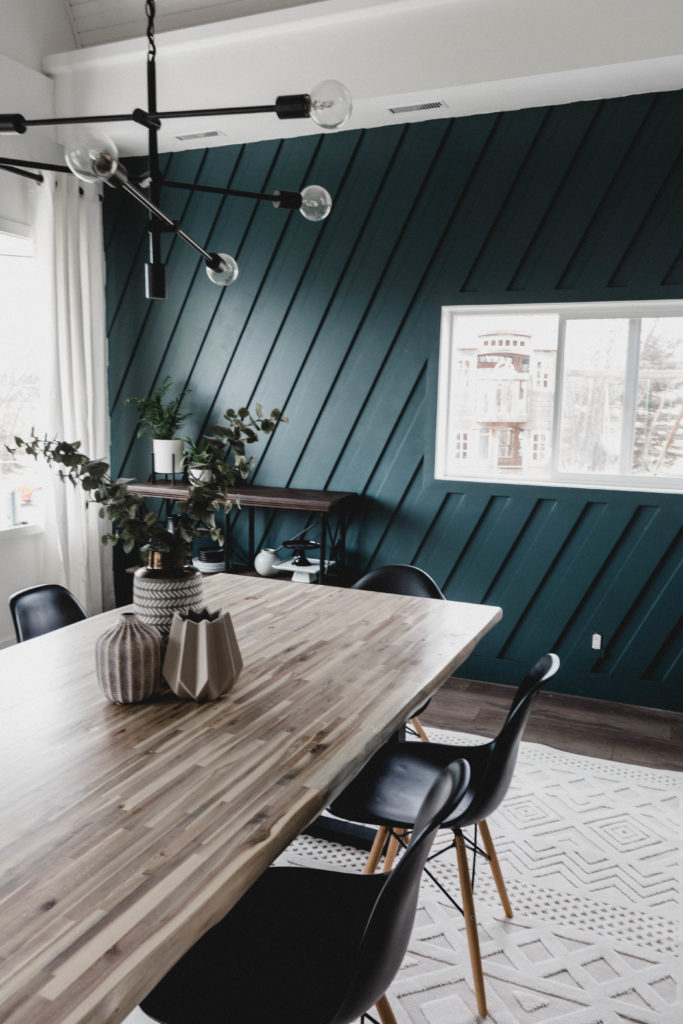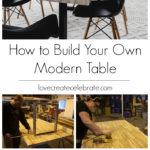Learn how to build a DIY live edge table with steel legs. A great tutorial sharing everything you need to know to make a modern live edge dining table!

Wow guys! It has been a loooooong time since we’ve shared a furniture build with you all! It’s not because we don’t have ideas! I typically approach renovations by tackling one room at a time. Of course we tackle tons of small projects in between. But typically, we tackle one room from floor to ceiling and then move to the next room. Most of the spaces we’ve tackled recently didn’t need any new furniture pieces. UNTIL we tackled our Dining Room! We desperately wanted to replace our old, worn out dining table, and the only way to do that, was to Build a DIY Live Edge Table!

*This post was sponsored by Home Depot Canada and may contain affiliate links. As always, opinions are 100% my own. For more information, please see my disclosure page.*
Live edge tables have always been popular, and continue to grow in popularity all the time. The live edge or natural edge of a piece of furniture refers to how we build the natural edge of the wood into the design of the piece. Our live edge table is created from two slabs with manufactured live edges that look beautiful. The rounded, more natural-looking edges really serve to add some character to the finished tabletop.
This table was one of three MAJOR projects that we wanted to tackle in just one weekend. I figured that we could easily complete this project in that time by building the first day, staining and finishing the next day, and giving one final finish coat on the last day. Showing everyone how to build a modern table, quickly and easily, was really important to us.
Sound ambitious? It wasn’t and here’s why: It’s made of only four main pieces! Two countertop slabs and two steel leg sets! Of course we used a few tools and miscellaneous supplies, but this has to be the EASIEST table build.
Materials needed for a DIY Live Edge Table:
- Two Wood Countertop Live Edge Slabs
(Or you could use these countertops – cheaper because they are a couple inches shorter!) - Two Steel Furniture Legs (2-Pack)
- Joining Biscuits
- Stain (we used Varathane Ultimate Stain White Linen)
- Varnish (we used Varathane Professional Clear Finish – Satin)
- Wood Glue
- Spray Paint (or what ever finish you desire for steel legs – we used Rust-Oleum Ultra Cover 2X Matte Black Spray Paint )
- Wood Putty
Tools Needed:
- Track Saw (or could used a circular saw and guide)
- Biscut Jointer
- Orbital Sander
- Belt Sander (Optional – but helps sand smooth joint faster)
- Brushes and clothes for staining and varnishing
- Drill and Impact
- Pocket Hole Jig
- Clamps
- Saw/Work Horses

How to Build a DIY Live Edge Table
The step-by-step guide to how to build a modern table with a live edge is listed below. If you’d like to see some of the highlights from our table building, you can watch our weekend renovation in the Instagram videos here and here.

Start by unboxing your live edge countertop slabs and placing them on work horses to get an idea of size and scale of your pieces.

How to Cut the Width for your DIY Live Edge Table
The width of your live edge table will depend on your space. We liked the width of our current dining room table, and chose to make our new table a similar width. If you want a wider table, you may not need to cut the slabs down at all.
Because these are long cuts, you may need to use a track saw. If you don’t have one, you can clamp a piece of wood down to act as a guide. you’re not sure how to do that, here’s a great video to show you how to do it:

How to Join Two Live Edge Slabs Together
The next step is to join the two countertop pieces together to make one large tabletop. If you do this correctly, the seam between the two pieces should be virtually invisible!
Biscuit joinery is the best way to ensure a good strong table. If you’ve never done biscuit joinery, or you’re not sure how, this video is a great overview!

We also added pocket holes to the underside of the table. By having both biscuit joints and pocket hole joinery, we ensured that the table would be built strong, and prevented any future bowing of the table slabs.
Sliding the two pieces together is when the magic happens! It finally starts to look like a great new table!

How to Cut the Length of your DIY Live Edge Table
Once the glue sets, it’s time to cut the length of your table. This is a pretty standard cut using the same tools as above. We wanted our table to be slightly larger than our old dining room table, but you can cut yours to fit your space.

How to Finish Your Live Edge Table
Finishing is one of the most important steps of a build project! If you rush the finishing, all of your hard work won’t shine the way you want it too. This may take a few rounds of sanding, puttying, and sanding again.
At this point you should also take the time to spray paint or powder coat your legs so that they are ready to attach to the finished tabletop.

When you’re ready, stain your table. Here’s a great step-by-step guide for how to stain a table. We used a White Linen Stain which looked beautiful when it was dry! We wanted the white to really soak into the wood, so we applied a generous amount of stain and let it sit for a couple of minutes before we wiped it off. If you’re not sure how long to let it sit, my suggestion would be, a) try it on a scrap piece that you cut off first, or b) do a small amount and let it sit for a shorter amount of time first, then do subsequent coatings. You can always add more stain, and each additional layer will usually make your stain deeper.
The final step is to varnish your table so that it’s protected and ready to be used on a daily basis.
Our Finished DIY Live Edge Table
It was a pleasure showing you all how to build a modern table. We were so happy with how our table turned out! It was the perfect piece to accent our new dining room. We did this entire live edge table in just two days. From cutting to attaching, to sanding and staining. Two days later we had a gorgeous table with a light, white tabletop.

You can really see the live edge detail in these photos. It’s a beautiful, subtle finish like this that gives a table character. Since we built this table, we’ve been asked countless times where we bought it, and we always get the honour of saying, “Actually, it’s a DIY! We built it!”.



I hope you like this build as much as we do! There’s nothing like showing off something that you built. There really is only a few steps involved with the DIY live edge table, and the results are amazing. If you have any questions about the build, please ask!

DIY Live Edge Table
Learn how to build a DIY live edge table with steel legs. A great tutorial sharing everything you need to know to make a modern live edge dining table!
Materials
- Two Wood Countertop Live Edge Slabs
- (Or you could use these countertops - cheaper because they are a couple inches shorter!)
- Two Steel Furniture Legs (2-Pack)
- Joining Biscuits
- Stain (we used Varathane Ultimate Stain White Linen)
- Varnish (we used Varathane Professional Clear Finish - Satin)
- Wood Glue
- Spray Paint (or what ever finish you desire for steel legs - we used Rust-Oleum Ultra Cover 2X Matte Black Spray Paint )
- Wood Putty
Tools
- Track Saw (or could used a circular saw and guide)
- Biscut Jointer
- Orbital Sander
- Belt Sander (Optional - but helps sand smooth joint faster)
- Brushes and clothes for staining and varnishing
- Drill and Impact
- Pocket Hole Jig
- Clamps
- Saw/Work Horses
Instructions
- Start by unboxing your live edge countertop slabs and placing them on work horses
- The first step is deciding on the width of your table. The live edge slabs we had were originally 25 1/4" wide. We found 50 1/2"too wide for our kitchen table and decided we wanted a final table width of 40 1/2", a total of 10" less. We wanted to make sure that the seam where the two slabs met would remain in the center, so cut 5" off each slab (cut down to a final width of 20 1/4").
- We used our track saw to complete this cut, however, if you don't have a track saw you could use a circular saw and guide (which could even be a 2x4 clamped to the table!) to make these long cuts.
- Next, we added biscuit joints to strengthen the connection between the two slabs. Mark out where you want your biscuit joints to be. We wanted a joint 4" from each end and than at every 12" throughout the slab.
- Cut your biscuit slots so the biscuit is in the center (from top to bottom) of the live edge slab. You may want to use a scrap piece of wood that is the same thickness as your live edge slab first to ensure the biscuit is cut in the correct position.
- Using a pocket jig drill pockets holes in the bottom side of your table. Ensure these don't line up with the biscuit slots. We put them in between all the biscuit slots and at the ends of the live edge slab. We alternated which slab we drilled the pocket holes from as we went. By having both biscuit joints and pocket hole joinery, we ensured that the table would be built strong, and prevented any future bowing of the table slabs.
- Glue and install your biscuits into the cut slots. You can also glue the edges of live edge slab at this points also.
- Slide both live edge slabs together and screw the pocket jigs. You should now clamp your table to ensure a nice tight fit once the glue dries.
- Once the glue sets (follow the manufactures recommendations) mark out the length of your table. We decided on cutting ours to 80" in length (slab originally was 96"). Again a track saw works best but you can use a circular saw and guide to complete this cut if you don't have one.
- Once your glue is dry, sand the center of the table to ensure a nice smooth joint between both slabs. You will likely have some glue that seeped out on both sides after clamping, you you'll want to get those all smoothed out. You can start with a belt sander (but be careful as it removes material fast!). Or just use a orbital sander starting with 60 girt sand paper, and moving up to 100, and then 220 grit sand paper until you get to a nice smooth finish. Sand the entire top, bottom, and ends of the live slab tabletop.
- Flip your table so that the top is facing upwards. Fill any cracks in the table with wood putty. We have found that the best way to fill these cracks is to mix natural wood putty and dust from your sander (if your sander has a dust collection bag). This puts some of the wood particles into your putty, and allows the stain later on to be a closer colour match to the rest of the table. Large putty marks on a tabletop always stand out in a not-so-good way. Finally, sand the table smooth after the putty dries.
- Paint and/or protect your steel table legs. We spray painted ours and it took about 3 coats to get a nice finish. You could also send the legs out to get them powder coated and that would result in a more durable finish.
- Flip your table so the underside is exposed. Layout your legs out where you want them. We set our legs back 9" (from the end of table to front of legs) or 12" (end of table to centerline of legs). We would this distance to both look nice, and be comfortable for the person in the end chair at the table (e.g. no table legs in their knees or anything!). Screw your legs in place. and pre drill the holes for the supplied screws.
- Wipe the table down with a damp cloth to prep for stain. Depending on your desired finish and stain choice you may want to use a wood conditioner prior to apply stain. We did not use one in this case, but it does open help prepare the wood to take in stain. If you are testing stains on a spare piece of wood, we would highly recommended testing the stains with the conditioner underneath (if you plan to use it) as well as with the clear finish on top. Both of these products could slightly alter the final look of the piece.
- When you're ready, stain your table. We used a White Linen Stain.
- Once the stain is set give the live edge table a coat of varnish, let it cure, and then give it a light sand with 220 grit sand paper and apply a second coat of varnish. Follow manufactures directions for stain cure times and application directions if needed.
Don’t forget to check out the entire post on HOW TO RENOVATE YOUR DINING ROOM IN A WEEKEND!
If you enjoy woodworking, you may enjoy our IKEA shelf hack! How to Make Your Own Wooden Floating Shelves!






Tony
Friday 8th of November 2019
Great project!! You've inspired me to try this on my own. Just a few questions, are the pocket holes overkill with the biscuits, glue and clamping? Also, how did you account for the wood expansion when connecting the legs to the tabletop?
Lindi
Saturday 9th of November 2019
Hey! Glad you’re trying it out! The pocket holes might be overkill, but we always err on the side of overkill, lol. Also, if you don’t have great clamps, the pocket holes will help squeeze the boards together. We didn’t worry about expansion really, and we haven’t had any issues. Our wood had been dried. I’d be more concerned with pine or something that splits easily!
Lindi and Russel From Love Create Celebrate: The Creative Hot Seat #2
Monday 9th of September 2019
[…] DIY Live Edge Table is one of my absolute favourite builds we have done. When you start “making,” there are always […]
Arlene Smerdon
Thursday 27th of June 2019
Love it! I’ll be asking for Home Depot gift cards this birthday. Would like to try a live edge hairpin leg coffee table
Lindi
Friday 28th of June 2019
That's awesome! Live edges always make beautiful tables!
Bob
Monday 10th of June 2019
This is great - thanks for this DIY. Can't wait to try it myself!!!